Ranch of the Friends: The Extraordinary Evolution of the L.A. County Poor Farm

I have officially been to one of the most fascinating places in Los Angeles County. No, it is not the new branch of Soho House about to open in DTLA, or that private club in the Staples Center everyone is always talking about. In fact, this place is deserted except for clutters of cats and was never the stomping ground of anyone rich or famous (unless they were there for a photo opportunity). But the L.A. County Poor Farm, later known as Rancho Los Amigos, was an exclusive club of sorts. It was a place of refuge for the destitute, the infirm, the addicted, and the elderly. It was a revolutionary concept when it opened in 1888, but since the late 1980s it has been left to become a ghost town. A ghost town whose lush overgrown grounds whisper of the comfort that many lost souls once found beneath its shaded trees.
The old Poor Farm campus is in Downey, right off the Imperial Highway. It is on the south side of the highway, while its grandchild, the still very active Rancho Los Amigos National Rehabilitation Center, straddles the north side. After some confusion, my friend and I located the abandoned complex, which appears for all the world like a lovely college campus that was quickly deserted due to some sudden disaster. We parked in front of the old administration building, alone except for two construction workers lying in the grass, eating their lunch in front of a condemned cottage. We explored the campus and found an abandoned church, a large Craftsman mansion (once the superintendent's home) with boarded up windows, a vine covered Spanish-style complex (once the women's ward), an empty auditorium, a giant laundry building, row upon row of patient housing that form streets like a Wild West movie set, a giant graffiti covered water tank, a bus stop, occupational therapy buildings, and wide green fields and concrete yards covered in trespassers' recent debris -- including an oddly ironic bottle of non-alcoholic O'Doul's.
Then there were the cats -- everywhere there were cats. On the boarded up doors, there were signs reading DO NOT FEED THE CATS, but we saw many multicolored cat dishes, proving this rule is not strictly enforced. Occasionally a jogger or a Rehab Center employee on a lunch break would pass by us, and the numerous broken windows and overturned office chairs led us to believe that there were probably some unfortunate souls sleeping the day away in the condemned buildings. The grounds were beautiful and fragrant and the leaves rustled a soothing rhythm. I say this not to whitewash the place, but rather to say that walking along the forgotten streets we did not feel like we were in the midst of lingering, unbearable suffering or institutional agony. We thought of all the homeless people trapped in the gritty hell of downtown L.A., and wished that somehow this peaceful place could become a refuge once again.
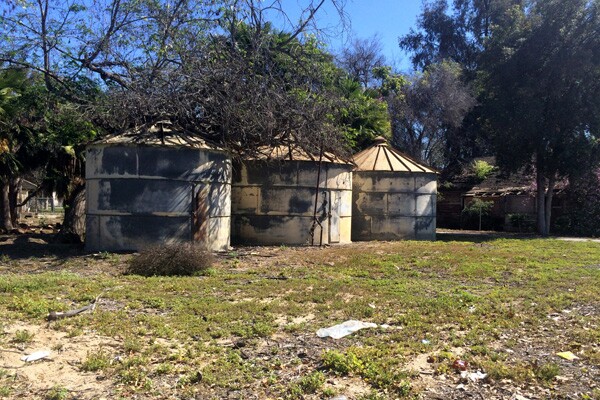




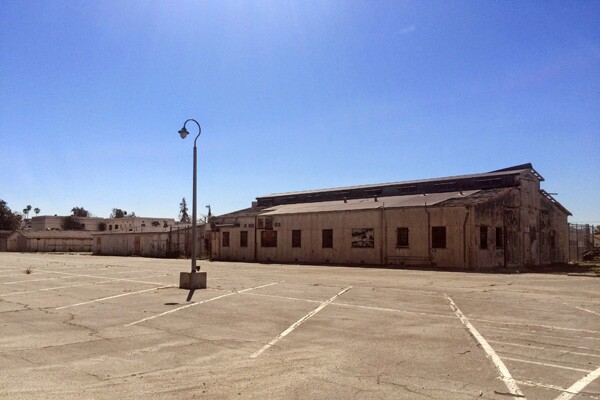
As Remarkable as a Waltz in the Midst of a Fast Day
A poor farm in the midst of an orange grove is as remarkable as a waltz in the midst of a fast day ceremony. The delightful innovation of housing the homeless and unfortunates in such environments belongs exclusively to Southern California, for no other part of America bears record of having done likewise: wrapped in sunbeams and wreathed with flower gardens, the Los Angeles County Poor Farm visibly resents the incongruity of its name, for it is rich in all the beauties of semi-tropical verdure, rich in productiveness of its orchards and fields, and rich in the great permeating joy of life, that trembles in every leaf and flower, transmitting the influence of its buoyancy into human hearts grown weary, dispirited and restless.--Los Angeles Times, November 6, 19021
Before it even officially became part of the United States in 1850, California had a large-scale humanitarian crisis brewing. Thousands of single men had rushed to the state in search of gold in 1848, only to find nothing but back-breaking labor and meager incomes. As these kinless men aged, they became destitute -- unable to work because of health problems or lack of education. The 1870s brought a flood of already ill people, lured to California by books like "California for Health, Pleasure and Residence," which promised an atmosphere "so pure" that it could cure almost any infirmity. These people, often from middle or lower class backgrounds, usually found themselves still ill, without networks of family and friends to support them. By the boom time 1880s, the L.A. County Hospital (opened in 1858) was overrun with such patients, along with more recent indigent arrivals via the newly constructed Santa Fe Railroad.
In 1887, the L.A. County Board of Supervisors decided to build a new institution that would house homeless, able-bodied "inmates" in a bucolic rural setting. That August, the county purchased 124.4 acres of farmland in unincorporated L.A. County, near the small town of Downey. The land was cleared and roadways were built. Shading trees were planted along with roses and other fragrant flowers. The original campus (situated approximately where the auditorium is today) featured three main buildings. An all-purpose Victorian style wooden building housed the kitchen, a reading room, trunk room, offices, and bedrooms for employees. Flanking this building were identical men's and women's wards, made of mesa brick, with long porches where inmates could "enjoy the evening breeze, smoke a clay pipe (supplied by the Farm), or take an afternoon nap in a rocking chair." 2 (Centennial, pg. 26) A working farm was also cultivated, to supply the inmates both at the farm and County Hospital with food. The excess was sold at market to defray the institution's cost.

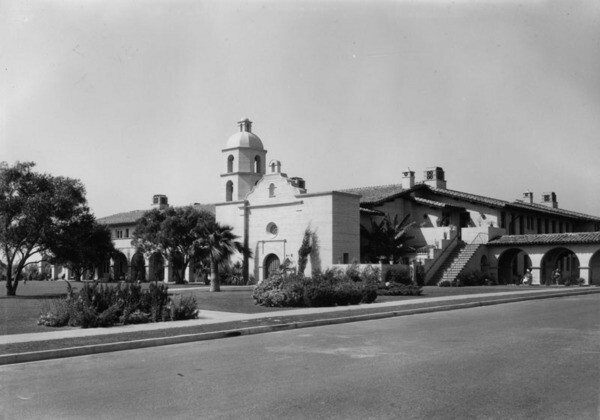
The first inmates were moved to the farm in December 1888. There were already around ninety men and women living at the farm in March 1888 when Dr. Edwin L. Burdick, a physician with farming experience, was hired as superintendent. By 1892, the L.A. Times reported:
[The Farm] is now an attractive place. Trees have been planted, including 3800 choice orange trees, which produce fine fruit, also eucalyptus trees, for windbreaks, cypress hedges, lawns and flowers. More than enough vegetables are raised for home consumption and some are sold. Alfalfa and sugar beets furnish food for the stock. A number of cows, hogs, and poultry yield more than sufficient milk, pork and lard and eggs to supply the inmates. 3
Over the next 12 years, under Dr. Burdick's leadership, the County Poor Farm grew into one of L.A.'s most lauded projects. As more buildings were built, it became a catchall institution, with wards for patients afflicted with mental illness, asthma, alcoholism, syphilis and physical disabilities. Most residents were elderly, and some were expected to stay only until they were well enough to work again. These men and women often performed light duties around the farm and were paid a small sum to take charge of the chickens or tend to sicker inmates. Then there were the inmates Dr. Burdick simply diagnosed with "old age," like a 100-year-old man from Britain who had fought in the battle of Waterloo. 4 Though most of the inmates had been poor laborers, there were exceptions like William Willmore, a once prosperous developer of what would become Long Beach, and James Eastman, a highly respected lawyer whose life had been ruined by alcoholism. While Willmore's friends eventually rescued him, no one came to Eastman's aid, and he was buried in the farm's (now lost) cemetery.
The farm became a popular place for the more fortunate to visit. Ladies' charity groups, the Chamber of Commerce, and health advocates from all over the country visited the farm to get ideas, hear lectures, and enjoy the farm's "novel" setting. A journalist visiting in 1902 described it thusly:
Near the noon hour the men assemble in the sunshine of the court, and there await the dinner bell. It is a picturesque sight to see these aged bearded men sitting, standing or reclining as they converse together...They seem peaceful and quite content but at the approach of a camera fiend, consternation reigns and they flock into the shelter of doorways like scurrying partridges, where they remain hidden till all danger is past. Occasionally because of a courteous desire to be accommodating, a man will consent to pose, but there is sadness in the acquiescence that merits one's gratitude. The women as a rule are firm, and absolutely refuse to have their pictures taken. Their plea is that they are too old and wrinkled and faded- that they were so different in their youth, but now no one cares for them. While talking, their eyes often fill with tears...The number of inmates at the farm average 165 men and 24 women, most of whom are decrepit with age, though there are paralytic patients, epileptics, imbeciles and persons with many other afflictions...Each inmate is supplied with a white iron bed with comfortable springs, good mattress, and an abundance of bedding, a chair, and a small stand...The rooms are immense and sometimes thirty beds are lined up along the side. There are no curtains in the men's apartments, and the flood of light is intense, quite different from the subdued quiet shadow influences of the women's department. Here the walls are decked with pictures cut from newspapers and magazines, the beds are spread with white counterpanes, and everything is as immaculately crisp and primly conventional as in a city mansion. At the windows that overlook the beautiful grounds, the old ladies sit and rock and meditate. Some are always busy knitting and sewing or tending a little garden that has been set aside for them... 5
Though the story paints a rosy picture, there were darker tales as well. There were occasional reports of inmate mistreatment. There were also stories of despondent residents like George Deacin, who drowned himself in a nearby river, and Bud Lewis, the farm's bread cutter, who jumped out of a window during a heated discussion. Concerns grew louder after Burdick retired. The farm suffered a series of lackluster superintendents. In 1911, a grand jury investigation resulted in mandated sweeping changes. These included fair distribution of food, clean and well lit wards, and "humane and kindly treatment" of inmates, with the promise that "any case of unnecessary force of violence on the part of employees is punished by instant dismissal." 6 Despite mismanagement, the 400-acre working farm (tended mostly by civilian labor) prospered, the orange crop alone bringing in $13,000 in 1909. This led one scribe to joke, "'Down to the County Poor Farm' is all a mistake, it should be 'Down to the County Rich Farm!'" 7

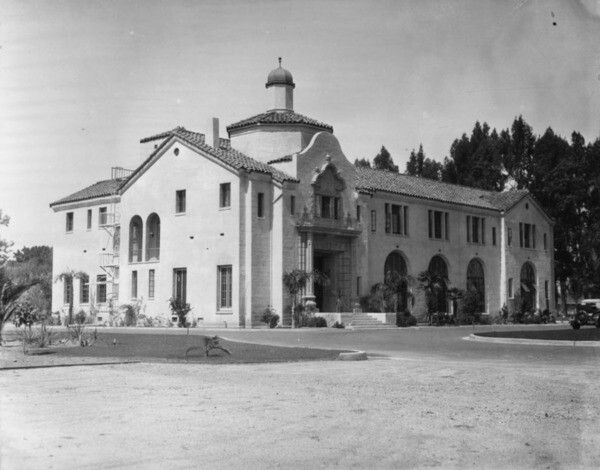
A Ranch, a Hospital and a Home
When a bit of sunshine hits ye, After passing of a cloud, When a fit of laughter gits ye, And ye'r spine is feelin' proud, Don't forget to up and fling it At a soul that's feelin' blue, For the minit that ye sling it It's a boomerang to you.--Captain Jack, aged 100, former sea captain and County Farm resident 8
William R Harriman, superintendent of the rancho, acted as Santa Claus, and ever accustomed as he is to suffering and poverty, his eyes filled with tears as he told of one little blonde girl who wanted another word with Santa and then whispered softly in his ear, "Thank you."--Los Angeles Times, December 22, 1937 9
In 1915, a new superintendent arrived who would transform the farm into a world class rehabilitation hospital and tight knit "small town," made up of thousands of patients, employees and their families. William Ruddy Harriman was only 26 years old when he and his wife, Elinor, moved into the large house reserved for the superintendent. A brilliant and kind man, Harriman had the personal touch that makes a born leader -- he memorized the name of every employee and patient ( he preferred the term patient to inmate) and told all he met to "Just call me Bill." 10 He was also firm in his beliefs about how the institution should be run, writing, "Cleanliness, sobriety and respect for the rights of the others are encouraged, and where necessary, enforced." 11 Hoping to erase the stigma of being a "poor farm," Harriman had the farm's name changed to Hondo (for the Rio Hondo, which ran through the property) in 1918. The area encompassing the County farm at Hondo was officially a town with its own post office; it would not be absorbed into Downey until the 1950s.
Over the first decade and a half of Harriman's reign numerous improvements were made to the farm. A new administration building, auditorium, infirmary buildings, medical offices, men's and women's psychopathic wards, additional housing for staff and patients, and bathhouses were built. Relationships with charitable groups were encouraged, early physical and occupational therapy was introduced, and the patient's social life was expanded with frequent motion picture shows, musical events, and arts and crafts. The farm itself continued to flourish, winning prizes for its milking cows and valuable Belgian and Percheron draft horses. By 1929, the average number of patients staying on the farm was around 1,900. 12 Increasing numbers of bedridden patients were being brought over from the county hospital. Able-bodied patients could participate in furniture making, work at the printing press, or play sports. Employees also lived at the farm and formed baseball teams, basketball teams, musical groups, and social clubs.
The Depression slammed into the county farm at Hondo. As funding dried up, the patient population exploded, necessitating the construction of a tent city that would be used for decades. In 1932, as the farm increasingly turned towards rehabilitation and medicine, the farm's name was changed to Ranchos Los Amigos -- "ranch of the friends." By 1934, Rancho Los Amigos had grown to 540 acres, with around 2,781 patients of all ages, infirmities and socio-economic backgrounds. The average stay around this time was 3 ½ years. Though many patients still came from poor backgrounds, the depression brought a greater number of lawyers, artists, scientists, writers and many lady music teachers onto the campus. An article from the L.A. Times described the variety of patients that year:
A trivial occurrence uncovered two more heroes at Rancho Los Amigos not so very long ago. An old fellow paused during a game of checkers in the recreation hall, to tug a tobacco pouch from a well worn pocket. As he wrenched it free, something fell to the floor with a pleasant ring- a Carnegie Medal for bravery. L.M. P. hastily retrieved the medal and slipped it back in his pocket. "Wasn't that a Carnegie Medal," asked Andrew J.H., opponent of P. in the checker game. P. nodded. "I got one too," grinned his adversary, and produced it. Two men with Carnegie medals, each awarded for an outstanding feat of heroism ... Royalty has found its way to Los Amigos along stony paths ...There is the countess Elizabeth S., whose father was a distinguished warrior in Prussia where the countess was born in 1861. The countess has his medal. But she is musical rather than martial. Among her treasures are songs which she had composed and which have been published...a graduate of the Paris and Berlin conservatories of music, her world today is a wheelchair ... [There is] the most ancient of colored gentlemen, Joseph Burns. Surely ancient best describes Joe, for as nearly as can be ascertained, he is 118 years of age...often his mind reverts with convincing clarity to his early life in a South African dugout, from which his little family could glimpse the sea. 13

The employees and patients generally lived in harmony. The power house whistle blew six times a day to signal mealtimes and bedtimes, and soothing concerts were often played over the Ranchos' campus-wide speaker system. Harriman's son, Bill Jr., and other children who grew up at the Rancho remembered a unique and oddly magical childhood, replete with a miniature zoo, tended by patients, and a small golf course. Bill Jr. credited his lifelong love of music (he became a jazz drummer) to a ragtag band of patients who would play on the streets of the campus every day. "It was very loosely organized and nobody bothered to read any music," he remembered. They would sing their way through folk and early American songs with ukuleles, guitars, violins and mouth harps. It was really the first live music I ever heard." 14
Of course, the ranch was a place full of very sick people with very real problems. Alcoholism was rampant. In 1935, many patients became ill and violent after drinking a bootleg shellac alcohol they had bought from a corrupt druggist in downtown Downey. There were sad stories like that of Eulalia Herbert, an elderly widow who had sewed or stuffed over $2,300 in relief money into her dress. Upon her arrival to the ranch, shocked nurses had to peel the money off her body when they went to give her a bath. More and more chronically ill children were also moved to the Rancho at this time.
With the passage of the Social Security Act of 1938 and the coming of World War II, many of the Rancho's elderly and able bodied patients moved to nursing homes or found outside work in the aviation industry and left the ranch. Some who considered the ranch home chose to stay on as paying patients. Some who could not leave, but who wanted to help in the war effort, formed a company called WARCO, which ran a subsidiary shop of Reeves Rubber Company in the Rancho Crafters building. There were other ways go help the war effort at the Rancho. Many wheelchair bound patients worked for Bendix Aviation and other aircraft companies, sorting through sweepings sent from local factories for usable nuts, bolts and usable metals. 15 Part of the ranch became an Army base called Camp Morrow. In 1944, an emergency hospital was founded, and a group of 32 polio victims was transferred to the Rancho. This was the beginning of the Rancho's polio ward, which would become one of the premier polio treatment and rehabilitation centers in the country.
The late '40s and '50s were a time of massive growth and change, and by 1951 the Rancho was considered a premier hospital, whose primary mission was "providing geriatric, medical and nursing care, as well as care for those suffering from chronic diseases or convalescing from medical or surgical conditions." 16 It also provided necessary "medical, surgical, and ancillary care for the largest concentration of respirators-dependent poliomyelitis patients in history." 17 There were no more prize Holsteins or endless orange groves. One by one, the hallmarks of the poor farm were shut down -- the mental health wards were shuttered, and the prize milking cows were sold. William Harriman retired in 1952, and died only two years later. By the late '50s, the County Poor Farm was a thing of the past, but Rancho Los Amigos Hospital was alive and well.

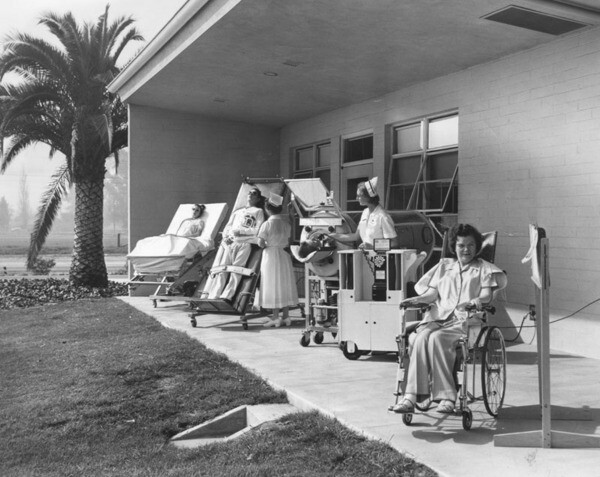
Modern Day Mercy
Over the next six decades the Rancho continued to grow. It became a highly respected county medical center of rehabilitation, research and hope. Its new growth was centered around the new campus on the north side of the Imperial Highway. Though most of the long term infirm and elderly patients died or were transferred to nursing homes or other facilities, a chosen few were allowed to stay. Until 1976, Eddie Higgins, a beloved developmentally handicapped man who had called the ranch home since 1926, could be found making his daily rounds, cheering everyone from doctors to fellow patients. 18
By the late 1980s, most of the buildings on the South Campus were abandoned. Over the years, numerous plans have been floated for the property, including the construction of an environmentally friendly county data center. But still the ghostly buildings of the poor farm campus remain, moldering reminders that charity is not a new concept, even in the Wild, Wild West.

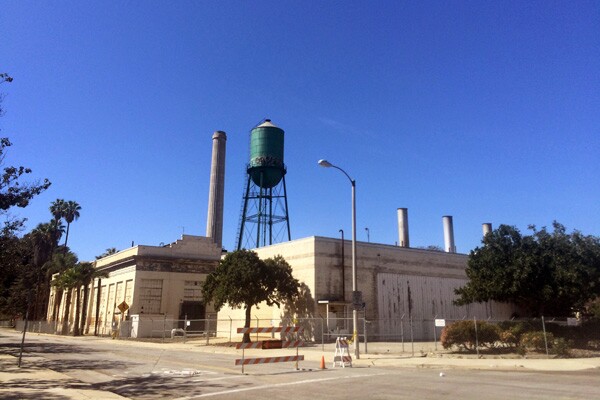
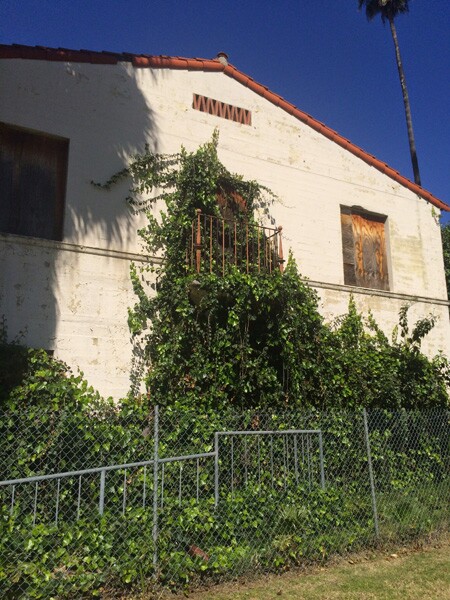


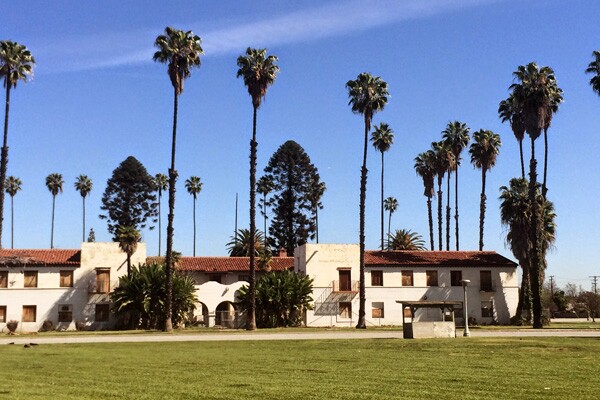
Further reading: "Centennial: Rancho Los Amigos Medical Center, 1888-1988," by Colleen Adair Fliedner
_____
1 "Farm amid orange blossoms" Los Angeles Times, November 6, 1902
2 Colleen Adair Fliedner, "Centennial: Rancho Los Amigos Medical Center, 1888-1988" Rancho Los Amigos Medical Center, 1990. pg. 26
3 "Los Nietos Valley" Los Angeles Times, October 21, 1892
4 Colleen Adair Fliedner, "Centennial: Rancho Los Amigos Medical Center, 1888-1988" Rancho Los Amigos Medical Center, 1990. pg 44
5 "Farm amid orange blossoms" Los Angeles Times, November 6, 1902
6 "Gets grilling, also praise" Los Angeles Times, October 4, 1911
7 "County poor farm really is reasonably rich farm" Los Angeles Times, September 18, 1910
8 "Farm for ill and destitute grew into a place of hope " Los Angeles Times, December 7, 2004
9 "Santa visits ill children rancho" Los Angeles Times, December 22, 1937
10 Colleen Adair Fliedner, "Centennial: Rancho Los Amigos Medical Center, 1888-1988" Rancho Los Amigos Medical Center, 1990. pg. 885
11 Ibid. pg 87
12 Ibid. pg 150
13 "Glory dies a-shambling" Los Angeles Times, November 4, 1934
14 Colleen Adair Fliedner, "Centennial: Rancho Los Amigos Medical Center, 1888-1988" Rancho Los Amigos Medical Center, 1990. pg 214
15 Ibid. pg. 215
16 Ibid. pg. 235
17 Ibid. pg. 235
18 Ibid. pg. 313)